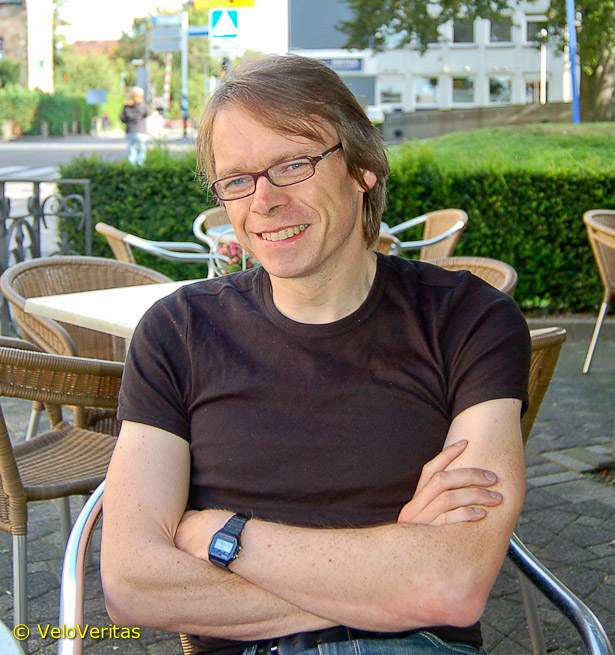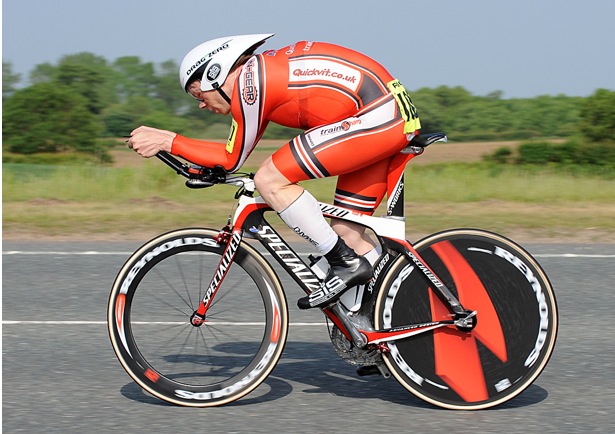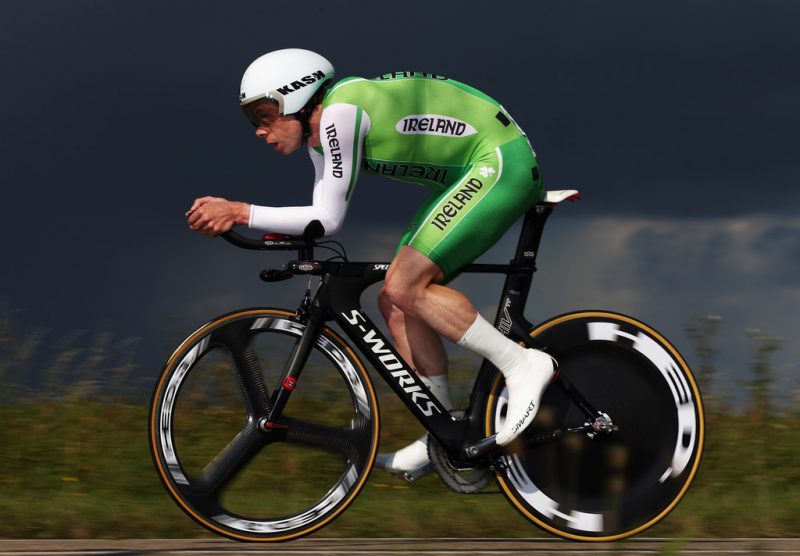
There’s only been one winner of the Cycle Time Trials 50 mile championship in the 21st century – and that’s Ulsterman Michael Hutchinson who has won the event 13 times, straight.
We caught up with the 38 year-old who just keeps getting faster and faster, the day after the World Elite TT Championship in Limburg, where he finished 46th @ 5:22 behind Tony Martin.
In fairness to the man who this year has broken the British 10 and 25 mile records, he did have the worst of the day – cold stinging rain which made the parcours very dangerous in parts.
The conditions saw Italy’s Marco Pinotti end up in hospital after crashing on rain slick road markings.
Our first question, as befits a sport based around numbers, was about those all important stats.

Can you list the championship wins for us please, Michael?
“You’d better check these; but I think it’s nine or ten 10 mile championships, six or seven 25 mile championships and I’ve won the 50 champs 13 times in a row – I’m the only winner, this century!
“And I’ve won the national 12 twice!
“Records-wise the 10 stands at 17:45, I broke my own record with that one; the 25 is a 45:46, that was Dave McCann’s record and the 50 stands at 1:35:27.”
How did you get into cycling?
“I was a rower when I was at Cambridge in the dim and distance past, but when I got my first ‘grown up’ job I decided I didn’t want to hang around a boat shed waiting on folk, anymore.
“I turned to running, which I quite enjoyed, but my girlfriend’s dad suggested I try cycling.
“I got into it properly when I was 24 or 25 but suppose I rode my first race when I was 23 – it wasn’t something I never intended to be good at.”
How do you maintain your motivation, year in, year out?
“I stop for five months of the year; from about now until February.
“I go out on café runs but abandon structured training completely.
“It doesn’t take me long to get fit; I guess if I did more work over the winter it would make me stronger but I don’t like going out in the bad weather and dark.
“I actually enjoy the process of getting fit, that’s where my motivation comes from, rather than thinking about winning races or setting records.”
What’s your favourite event?
“Not the ’12’ anyway! I’m baffled by how people can enjoy riding those.
“The ‘10’ is best, its fast – hit it hard and hang on.
“I like going fast, there’s not the same thrill in riding a ‘100.’
“It doesn’t have to be a big event; for example, there’s a local race, two laps of a six mile circuit – a twisty and technical 12 miles.
“I’ve always wanted to complete that course at 30 mph; I achieved that this year and it gave me a great deal of satisfaction.”

You look very ‘slippery’ on the bike, have you spent much time in the wind tunnel?
“I’ve spent some time, but not as much as folks think, maybe six or seven hours and that’s including doing product development stuff – not the hundreds of hours which folk say to me that I have.
“It was in the ‘Drag2Zero’ wind tunnel, working with Simon Smart who worked on the Giant Trinity and Scott Plasma time trial bikes.
“My position is comfortable, I think that most folks can only go as low as is comfortable, if they try to go too low then they start to stretch and that puts their shoulders out of place.”
What gearing do you usually ride?
“It doesn’t matter, unless it’s like yesterday where you need gears to cover all the options with the climbs and descents.
“I ride 56/44 with 11 up on a 10 speed cassette and try to keep my revs around 100 – but it’s not something I worry about.
“Guys say to me; ‘what gear were you in when you passed me?’ I reply that I’ve no idea.
“It strikes me that a lot of riders spend their whole race looking down at the block.”
What’s your take on tyres?
“I ride Veloflex tubulars but I have to pay for them myself so I don’t want to advertise them too much!
“I think I may ride clinchers, next year – I have a set of HED clincher wheels which I’ll ride them on.
“The first thing is that they’re perfectly round – even the best handmade tubs aren’t round.
“Then there’s the practical aspect of changing tyres to suit the course – it’s a lot easier with clinchers.
“And there’s the fact that you have an alloy braking surface – which is good.
“If they have latex tubs then I think they’ll be every bit as fast as tubulars.”
Tell us about your training.
“I do 90% on the road but I don’t do massively long rides – three hours would be my maximum, that’s not a lot compared to some people.
“I do it at what you’d say was a consistent pace but with specific efforts included – my coach Jamie Pringle and I play around with heart rates and power.
“I don’t do much short high intensity stuff, my high quality efforts tend to be within my road runs, but towards the end of the rides.
“I don’t actually do that much interval work, maybe five times each year with three of those as part of the build up to the 10 and 25.
“I find that if I do intervals I go over the top and off the boil.
“I find the SRM system very, very useful it lets you quantify, not guess.”

What were your average watts, yesterday?
“Now that’s a secret – I have a healthy respect for my opposition and if I tell you that it lets them work out all kinds of things!”
How do you fit the bike in with working?
“I’m a freelance writer, as well as my Cycling Weekly column, I do other bits and pieces and I’m working on another book.
“I do most of my writing from 6:00 pm until 11:00 pm which allows me to do my training in the morning.”
How did you get into race commentary?
“I met David Harmon at the Worlds, last year and he invited me to join them in the commentary box, after my ride.
“It’s developed from there; I’ve done the Tour and Olympics and was in the box after my ride, yesterday.
“I was chosen for a random control and I think it’s the first time an UCI dope test chaperone has been in the Eurosport commentary box!”
You have a big engine – why did you never ride the road?
“I used to ride the road a fair bit when I started; I rode quite a few Premier calendar races.
“I was working as an academic lawyer back then, lecturing in law.
“Giant approached me and offered me a contract as a professional time trial rider.
“Back then, 2001/2 the sport of time trialling enjoyed massive coverage in Cycling Weekly and they reasoned that if I was winning races every weekend, getting pictures and reports in the magazine then it was better value for them than sponsoring a team.
“But that meant I was limited in the road events I could ride.
“If I’d ridden a time trial on the Saturday then I could ride a road race on the Sunday, but the motivation wasn’t the same.”
Tell us about yesterday’s ride.
“I’m not terribly pleased with it and whilst I don’t like to make excuses, I did ride in the cold on wet roads with a wind which changed.
“When I watched Tony Martin come home on dry roads in warm sunshine, I was thinking; ‘that would have been nice.’
“But that’s the thing with point time trials courses; you are at the mercy of the weather.”

But wouldn’t you need to come off a continental road season to do that course justice?
“Of course that would be better, but I’m 38 and not a professional roadman.
“There aren’t many riders have the luxury of knowing months in advance that they’ll be riding the Worlds TT and can prepare properly for it.
“I’ve only known for a few weeks.”
In an ideal world what would you have done differently?
“I’d have got to know the course better – I rode it three times but it wasn’t enough.
“During the race I was still coming into corners and wasn’t absolutely sure where I was and how to tackle it.
“And I’d have gone back over to Ireland for a few weeks for a training camp at my parents’ home where I’d have ridden in the mountains working on my climbing and descending skills.
“I’m also sitting here perhaps two or three kilos above what I’d call ‘my ideal racing weight’ – which is probably five kilos heavier than a continental DS would say was my racing weight.
“On a course like yesterday, with that elevation, every kilo is worth 10 seconds.
“I reckon that I gave away maybe 20/25 seconds on the Cauberg.”
Why has time trialling lost the limelight in the UK, do you think?
“Cycling in Britain has changed a lot – when I started, there was no such thing as a sportive.
“There were guys who travelled abroad to do Fondos and the like, but they had to explain to you what they were.
“If you speak to bike shop owners they’ll tell you that since 2005/6 the sportive market is what it’s all about; and Cycling Weekly has changed focus towards that market, too.
“The problem was that time trialling had no ‘plan B’ – they relied so heavily upon the coverage from Cycling Weekly that when it moved on, there was nothing else.
“There are still a lot of people who ride them – good riders.”
What’s still on the Dr. Hutch ‘to do’ list?
“Like I said, the process is the thing.
“I’d love to find more speed and ride the Worlds time trial, again – but prepare properly for it.
“The Commonwealth Games will be coming around, again – I’ve been fourth in the time trial in the last two.
“The same old, same old, I suppose.
‘I’m happy, I’ve realised most of my ambitions – I just want to train better, get faster and enjoy the process.”



